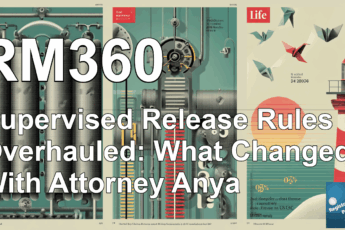Headline:
Unlocking Second Chances: Rethinking Societal Barriers for Formerly Incarcerated Americans
Introduction:
Every year, more than 600,000 people walk out of America’s state and federal prisons hoping for a fresh start. Yet for most, the promise of a “second chance” is more rhetoric than reality. As April marks Second Chance Month—a time declared by Congress to raise awareness about reentry challenges—society is compelled to confront a pressing question: what does it really take for individuals with criminal records to successfully reclaim their lives? Despite political gestures and bipartisan resolutions, real-world obstacles persist, making financial independence and community integration out of reach for millions. In this article, we’ll explore the systemic barriers these individuals face, how public policy and cultural attitudes shape their journeys, and what meaningful reforms could help more Americans transition from prison to prosperity. Readers will leave with a deeper understanding of the problem, an examination of current and proposed solutions, and practical insights into making “second chances” a genuine opportunity rather than a fleeting ideal.
Second Chance Month: Symbolism and Reality
April’s recognition as Second Chance Month is a bipartisan effort, meant to draw attention to the millions of Americans reintegrating into society after incarceration. The symbolism is powerful; it suggests redemption, hope, and the belief that individuals can grow and contribute anew. However, the gulf between this ideal and reality remains stubbornly wide.
The Staggering Scale of Reentry
According to the Bureau of Justice Statistics, over 600,000 people are released from American prisons each year. Yet, nearly two-thirds are rearrested within three years. The “why” behind this high recidivism rate is complex, but one factor stands out: meaningful employment remains elusive for many with a criminal record. Without reliable income, basic stability is hard to achieve, leading many to cycle back into the criminal justice system.
The Economics of Incarceration
The costs of incarceration are immense, both financially and socially. In high-cost states like California and New York, it’s not unusual for taxpayers to spend upwards of $50,000 annually per inmate. By contrast, advocates argue that redirecting a fraction of these resources—say, $35,000 annually per person—toward meaningful reentry programs could produce better outcomes and cost savings. The fiscal case for smarter investment grows stronger when the broader societal costs of repeat incarceration, broken families, and lost workforce potential are considered.
The Hard Numbers: Disparities in Employment
A significant barrier facing those with criminal records is persistent unemployment. A study from the Prison Policy Initiative found that formerly incarcerated individuals are unemployed at a rate nearly five times higher than the general population. With the national unemployment rate hovering below 5%, the rate for those recently released is around 20%—one in every five is unable to secure work. For Black men with prior convictions, the unemployment rate is even higher, reflecting not just the stigma of incarceration but also entrenched racial disparities in hiring practices.
The Power—and Peril—of Background Checks
Employers routinely conduct background checks, and in the digital age, even a cursory internet search can dredge up offenses from years past. Sometimes, even nonviolent misdemeanors or old infractions become permanent barriers, making it nearly impossible for people to move beyond their records. This reality stands in sharp contrast with American ideals of rehabilitation and self-improvement.
The Poverty Trap and Recidivism
When former inmates cannot access stable employment, financial desperation can drive them back toward crime, trapping them and their families in cycles of poverty and incarceration. The cost isn’t just personal; it affects communities, inflates public spending, and perpetuates structural inequality.
Rethinking Solutions: Policy Proposals and Social Shifts
Breaking the cycle requires more than symbolic gestures. It demands structural reform and a reevaluation of how we balance transparency, public safety, and individual privacy.
1. Limiting Online Record Accessibility: The Right to Be Forgotten
The article suggests that U.S. search engines and third-party data aggregators could, after a designated period (especially for nonviolent offenses), remove criminal records from public search results. This policy draws inspiration from the “right to be forgotten” upheld in European countries like Germany, where individuals can petition for old or irrelevant personal information to be delisted from search results. While the United States values open records and transparency, there is a growing argument that perpetual online access to decades-old convictions undermines reentry efforts and contradicts American ideals of second chances.
Potential Challenges:
– Balancing privacy with legitimate public safety and employer concerns
– Deciding what offenses qualify for digital removal
– Determining an appropriate waiting period before information is suppressed
Global Context:
The European Union’s General Data Protection Regulation (GDPR) provides a model, allowing individuals to request erasure of certain personal data under defined circumstances. Adapting such approaches could address the permanent digital stigma attached to criminal records in the U.S.
2. Incentivizing Employers: Targeted Tax Credits
Financial incentives can encourage employers to hire individuals with criminal records. The article champions federal tax credits for businesses that do so, helping offset perceived risks and financial concerns associated with such hires. While some tax incentives already exist (such as the Work Opportunity Tax Credit), their scope is limited and often poorly publicized. Moreover, eligibility requirements can be convoluted and time-limited.
Key Considerations:
– Simplifying and expanding these incentives could spur more businesses to participate
– Ensuring such programs are stable and not subject to sudden legislative expiration
– Pairing incentives with meaningful support for both employers and employees
Supporting Data:
A 2018 report from the Society for Human Resource Management (SHRM) found that over 80% of managers and employees believe colleagues with criminal records perform the same or better than those without. Financial incentives can thus be part of a virtuous cycle, promoting diversity, redemption, and workplace stability.
3. Supporting Entrepreneurship: Ownership as Empowerment
Recognizing that not everyone will find opportunities in traditional job markets, the article spotlights entrepreneurship as a critical alternative. Formerly incarcerated individuals who launch small businesses can take control of their livelihoods and bypass employer bias. Notably, customers rarely scrutinize a business owner’s background; they care about quality and reliability.
Programmatic Support:
Entrepreneurship training programs, seed funding, and mentorship can help justice-impacted individuals translate skills and resilience developed during incarceration into viable enterprises. Nonprofits like Inmates to Entrepreneurs—founded by Brian Hamilton, a nationally recognized entrepreneur and fintech pioneer—offer mentorship and resources to foster such ambition.
Real-world Application:
Several states and organizations, recognizing this potential, have started to offer grants and accelerators targeting justice-impacted entrepreneurs. For example, Defy Ventures runs entrepreneurship boot camps for people with criminal histories in multiple U.S. cities.
The American Tradition of Second Chances: History and Irony
The concept of new beginnings is embedded in America’s DNA. Most non-Indigenous citizens descend from immigrants—many of whom fled persecution, poverty, or the very types of trouble that led to criminal records. Ellis Island welcomed millions, no questions asked, granting a chance to start over.
Yet, as society has grown more complex and data more accessible, there is a deepening irony: the nation that so prizefully markets itself as the land of opportunity is often the least forgiving when it comes to allowing its own citizens a clean slate.
Brian Hamilton, the article’s cited author, underscores this contradiction. As the founder of Inmates to Entrepreneurs and a trailblazer in the financial technology sector, Hamilton has made it his mission to prove that ownership and self-determination can be vehicles for redemption. He believes in the transformative power of second chances—not just for individuals, but for communities and the economy at large.
Looking Forward: Can Second Chance Reforms Succeed?
Despite bipartisan support for Second Chance Month, meaningful reforms often falter amid broader political battles over “law and order.” Skepticism lingers that, in the current climate, sweeping legislative change is unlikely.
But history does offer hope: society’s standards, and the technologies that structure them, are always evolving. If Google can modify its algorithms to fight misinformation, as it routinely does, why not to support reentry and reintegration? If companies can be convinced—through tax policy or moral argument—to open doors, and if communities remember their own immigrant roots, real change is possible.
Conclusion: Bridging Rhetoric and Reality
Second Chance Month must become more than a symbolic gesture; it must galvanize substantive policy and cultural shifts. America owes it to itself—and to the millions seeking redemption—to dismantle harmful reentry barriers. By reforming digital privacy laws, improving hiring incentives, and investing in entrepreneurship, the U.S. can transform “second chances” from an aspirational slogan into a lived reality.
Actionable Takeaways:
- Advocate for Digital Privacy Reform: Support policies that limit public access to old, nonviolent criminal records in online searches after a reasonable period, balancing privacy with public interest.
- Encourage Inclusive Hiring: As a business owner or HR professional, leverage available tax credits and look beyond criminal records, focusing on skills and potential.
- Support Reentry Entrepreneurship: Contribute to or partner with organizations that mentor and fund aspiring business owners with criminal histories.
Further Reading and Resources:
– Inmates to Entrepreneurs
– Prison Policy Initiative employment reports
– SHRM: Getting Talent Back to Work Initiative
By taking practical steps and championing policy reforms, every American can help restore the nation’s promise of a true second chance.




Leave a Comment